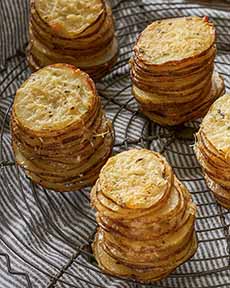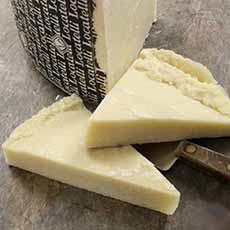FOOD FUN: Potato Stacks With Romano Cheese
|
Have some fun with potatoes this weekend: Make potato stacks in your muffin cups. The potato slices have crisp edges, and can be eaten like a stack of pancakes, in single slices, or whatever way creativity guides you. (We picked them up and ate them like chips.) The recipe, from Wisconsin Cheese, uses romano cheese for its tangy flavor to dishes. Romano is similar in texture to parmesan, but has a sharper, more assertive taste. There’s more about it below. Ingredients 1. HEAT the oven to 400°F. 2. COMBINE the potatoes, butter and rosemary in a large bowl. Season with salt and pepper. Sprinkle with Romano; toss to coat. 3. EVENLY STACK the potatoes in six lightly greased muffin cups. (The stacks will be taller than the muffin cups.) 4. COVER the pan with aluminum foil. Bake for 35 minutes. Uncover; bake for 20-25 minutes longer or until the potatoes are golden and crispy around the edges. 5. RUN a knife around edges to loosen the potato stacks; plate. History Few cheeses in the world have such ancient origins as Pecorino Romano. For more than 2,000 years, flocks of sheep that graze freely in the countryside of Lazio, the region of which Rome is the capital. These sheep produced the milk from which the cheese is made. In fact, it was made in Roman countryside until 1884, when a city council ruling over cheese salting in shops caused producers to move to the island of Sardinia. Pecorino Romano was a favorite of the ancient Romans, from royalty to soldiers and everyday citizens. Columella (4 to c. 70 C.E.), a prominent Roman writer on agriculture, gives a detailed description of pecorino production in his “De re rustica” [source]. The method of production of the cheese was also described by Pliny the Elder (c. 23/24 C.E. to 79 C.E. [he died during the Pompeii eruption]). Today’s Pecorino Romano is made from the same recipe, albeit with pasteurized milk. A hard grating cheese, “pecorino” refers to sheep’s milk cheese (pecore means sheep in Italian). Romano indicates that the cheese is of Roman provenance. While Parmigiano Reggiano and Grana Pedano are the favorite grating cheeses of Northern Italy, Pecorino Romano is the choice in the southern portion of the country. It’s a bit drier and saltier than northern Italian grana (grainy) cheeses. When you see the word “genuino” (genuine) on the label, you know that it’s a Romano made in Lazio. Genuino Pecorino Romano has a grainy, crumbly texture that is much more flavorful than other Romanos. With the expansion of Rome and the value of real estate, some of the herd was moved to the expansive meadows of Sardinia. Today, just one producer, Locatelli (photo #3) makes the cheese in Lazio. Today, most Pecorino Romano is made in Sardinia or Tuscany. These regions have very similar pastures and breeds of sheep to Lazio, ensuring a consistent flavor and quality. Pecorino Romano is typically aged for one year. Pecorino Romano is a D.O.C. cheese (Denominazione di Origine Controllata, which translates to Controlled Designation of Origin). This means that the name protected by law. Other regions and countries can make this type of cheese, but it must be called, simply, Romano. There are numerous Pecorinos made throughout Italy, but only one is Pecorino Romano. The D.O.C. cheese production is overseen by the Consorzio per la Tulela del Formaggio Pecorino Romano, which ensures quality standards are met. The label guarantees authentic production techniques and a distinct flavor. Enjoy it grated into soups, salads, pastas and gratin casseroles. Sprinkle it over grains and vegetables, particularly potatoes and tomatoes For dessert, serve chunks drizzled with honey, along with sliced pears. And while it isn’t an eating cheese, you can cut a piece to enjoy with a glass of hearty red wine. For the best flavor, don’t buy grated Romano. Instead, buy a wedge and “grate as you go” (photo #4). Keep the wedge tightly wrapped in the fridge. Perhaps the best-known brand for Pecorino Romano in the U.S. is Locatelli (photo #3): a D.O.P. cheese, hard and dense, strong and sharp in flavor, pale yellow in color. |
|
|
|
|
||









